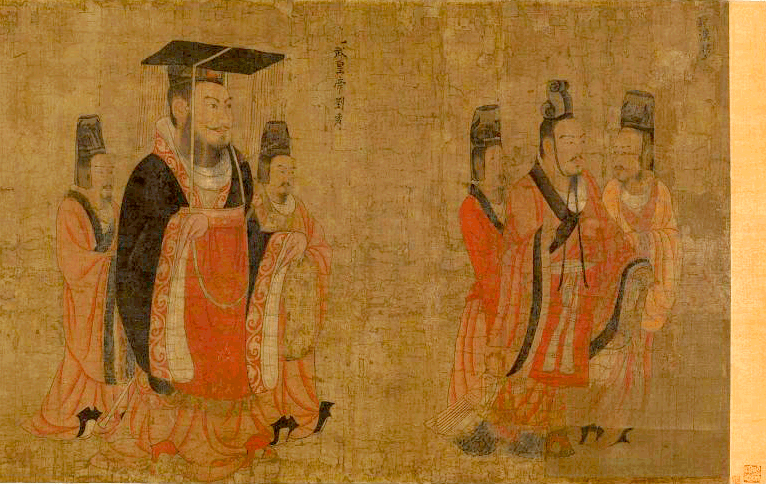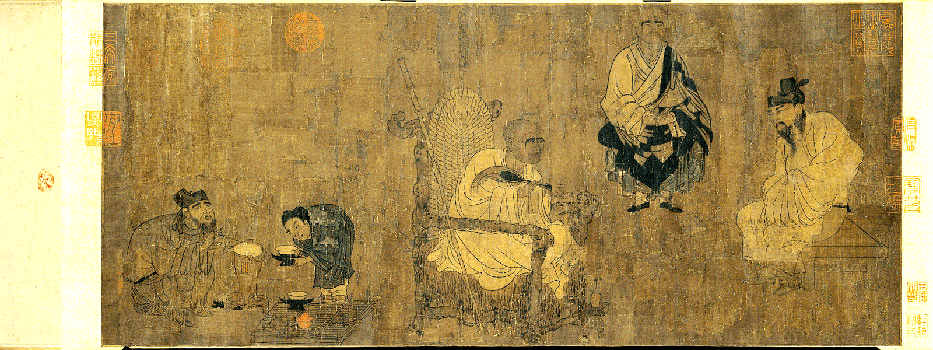Yen Li-pen
Chinese painter – T’ang dynasty

The Chinese painter Yen Li-pen (died 673) was the greatest master of the early T’ang dynasty. He was primarily a figure painter, and his style expresses the confident, expansive air of his age.
Yen Li-pen was born in the late 6th century in Wannien, Yung-chou (modern Shensi Province). His father, Yen P’i, was a court painter and official under the Northern Chou and Sui dynasties; and his older brother, Yen Li-te, was also a painter who rose to the position of minister of the Board of Works. Yen Li-pen succeeded him in this post in 656, and in 668 he became one of two ministers of state. Despite his high offices in government, he was regarded primarily as a painter and summoned to perform at the Emperor’s whim. In consequence, Yen Li-pen is said to have discouraged his son from becoming a painter.
Yen Li-pen’s art typifies the grand imperial spirit of the early T’ang period. His greatest predecessor, Ku K’aichih, had developed a style featuring a fine brush line “like silken thread,” that was well suited to an intimate, humanistic expression. Yen Li-pen’s brushwork is described as “iron-wire line,” a thin, hard, even lineament used with heavy shading and bold color, which is better suited to a powerful, monumental art.
The most impressive painting surviving under Yen’s name is the Scroll of the Emperors in Boston, portraying 13 emperors from the 2d century B.C. to the 7th century. Each monarch is depicted with attendants and is effectively characterized as an individual, as we know from accounts of their personalities in dynastic annals. The overriding impression, however, is one of majesty and remote dignity, quite different from the gentler, more personal art of Ku K’aichih. A similar work in Peking, representing Emperor T’aitsung receiving a foreign ambassador, reinforces this image, though it is a somewhat later copy. Several of Yen Li-pen’s portraits of meritorious officials, painted at imperial command in 643, have been preserved as rubbings made from engravings on stone cut in 1090.
A quite different style is seen in a lovely handscroll also in Boston. Scholars of the Northern Ch’i Dynasty Collating Texts has been attributed to Yen Li-pen at least since the beginning of the 12th century and is among the most remarkable of all early Chinese figure paintings. As in the works mentioned above, the figures are placed against a plain background, without setting, and the brushwork is fine and even. However, the color is pale and transparent, there is relatively little shading, and each figure is individually conceived in the most sensitive manner. The interaction between members of the group is also striking. If the work is truly related to Yen Li-pen, then it reveals a more penetrating and personal master than his other works suggest.
After his death in 673, Yen Li-pen was honored by the Emperor with the posthumous title Wen-chen (Cultured and True). His art became a classical ideal to later masters.
The story of Hsiao

This painting illustrates the story of Hsiao I, an official under the T’ang emperor T’ai-tsung (r. 627-649) who was ordered to acquire the “Orchid Pavilion Preface” by any means, including trickery and theft, from the monk Pien-ts’ai, who had the original (by Wang Hsi-chih, China’s “sage calligrapher” whose works were most admired by the emperor). Among the figures here, the simple and honest looking one sitting cross-legged is the old monk Pien-ts’ai, while across from him sits the conniving Hsiao I. To the left are attendants preparing tea. The background is blank, yet the artist has used the arrangement of motifs to suggest a sense of space, which is a feature of T’ang painting. Whether the attribution to or association with Yen Li-pen is accurate, however, still remains unclear.




